Deluxe Wabar Specimen Pack Meteorite, Impact Melt, Impactite, Pearls, GlassRain
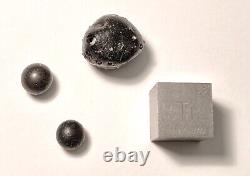
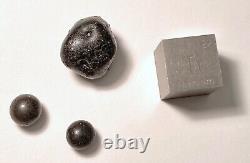
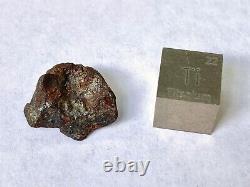



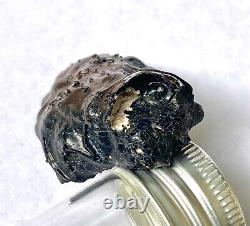
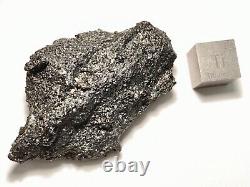

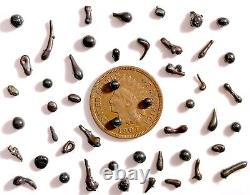


Offered as a single Wabar specimen package for your consideration are. Three Wabar "pearls" (1st & 2nd photos). One meteorite (3rd & 4th photos). Two samples of impact melt glass (photos 5-7 and 8-9), in one of which a white impactite interior can be seen. A collection of glass "raindrops", sometimes also called "pearls" (10th photo).
A small representative sample of unaltered sand from the impact site. All of the samples were collected during a year 2000 expedition to the Wabar meteorite impact site located in the Kingdom of Saudi Arabia. While there he successfully reached the Wabar site and collected the samples being offered. The penny coin and 1 centimeter cube in the photos are not for sale. Samples from the Wabar site are extremely rare due to their limited and declining number-disappearing beneath drifting sands-and also the extreme difficulty of reaching their remote desert location in the Empty Quarter (Ar Rub' al-Khali). The impact event is described in various publications. An article in the November 1998 Scientific American is an excellent detailed description for laypersons. The meteorite being offered (3rd & 4th photos) is 3.4 grams and is 1.5 cm. It is not a "shale ball" or other heavily degraded sample. It is a solid metal fragment of the asteroid, and has suffered little alteration except for some patches of iron oxide on its surface. "Impact melt" is glass that formed when the desert sand was flash melted by the shock wave of the impacting 3,500-ton asteroid.About 10% of its composition is iron and nickel from that disintegrating meteor. Two irregularly-shaped samples are included in the package: one with a vitreous surface and the other with a rougher exterior. Both are typical of this class of rare object, with micro-fractures (formed when glass cools quickly) and "pimples" on their surfaces. The latter are tiny droplets that swirled in the violent turbulence above the impact until they could adhere to larger lumps of glass-caught up in the same maelstrom-after those cooled enough to become "sticky". Most Wabar impact melt is black-colored, and only occasionally brown.
The vitreous sample 10.2 gm. Is a combination, being black on one side (5th photo) and dark chocolate brown on the other (6th). The black side has several pits formed from tiny bubbles of gas escaping. During the specimen's formation a larger gas bubble at one end burst (7th photo), revealing an interior composed-partially, at least-of a white material called "impactite". Impactite formed beyond the flash melt zone where the still expanding shock wave welded individual sand grains into something resembling white sandstone.Fragments were blown into the air and formed exteriors of impact melt, possibly due to the fierce radiant heat of the rising fireball. The second impact melt sample 12.3 gm. Is rough on one side (8th photo). It looks like a mixing of low viscosity glass with unmelted sand. The other side is smoother (9th photo) and has some sand grains-burned brown by the heat-embedded in it.
The three Wabar "pearls" in the 1st & 2nd photos are also impact melt. Not surprisingly, these black glass objects were once believed by the Bedouin to be jewelry worn by women of an ancient city that God destroyed. The larger, less spherical specimen has several openings where gas bubbles burst. Some of these pits appear to have partially closed before the object solidified.
A number of glass "raindrops" (10th photo) are also included in the package. The following explains their origin. Some of the melted sand and asteroid-a portion perhaps vaporized-formed a massive upward rising fireball that probably reached the stratosphere. There, the gas and liquid spread out to form a glowing mushroom cloud, which condensed and rained down as molten glass droplets across a wide area.The ones being offered were found in a small area of the original desert surface north of the impact site. Exposed between drifting dunes, it was littered with the black "rain".
Those that were pulled apart by wind stresses or rapid rotation as they cooled are tear-shaped, while others are the slightly flattened spheroids typical of falling water drops. The barbell shapes are seldom found. These were likely spinning glass droplets that cooled before they could fly apart. The sand is unaltered except for slight contamination by tiny fragments of black impact melt and white impactite mixed into it by subsequent sandstorms.


